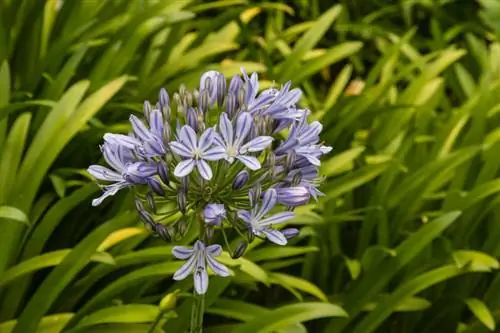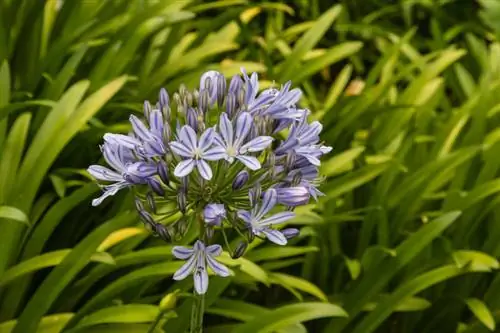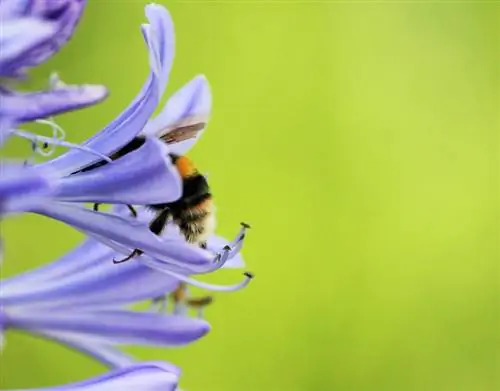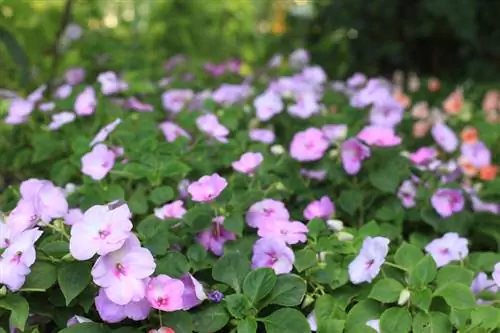- Author admin [email protected].
- Public 2023-12-25 17:45.
- Last modified 2025-01-23 11:22.
Where the African African lily lights its flower fireworks, it attracts everyone's attention. Wonder no longer how to properly cultivate the emerging summer beauty. The following answers shed some light on the matter.

How do you care for an African lily for optimal flowering?
The African lily, also known as the African lily, is a showy plant with long inflorescences that can bloom in a variety of colors. Optimal care includes a sunny, protected location, regular watering, moderate fertilization and a cool winter for maximum flowering.
Planting African Lily Correctly
As a bulbous flower, planting is very easy. How to do it right:
- Create drainage in the bucket above the bottom opening
- Fill the container half or two thirds with loose, nutrient-rich substrate
- Plant the tuber so deep in the middle that the shoot tips are just covered with soil
- Water and mulch generously
Planting an African African lily directly into the bed carries a high risk of failure. If you want to dare the experiment, choose a sunny, sheltered location without exposure to wind. Clever hobby gardeners put the flower and its pot in the ground to take it out in the fall for safe overwintering.read more
Care tips
Care for an African African lily according to the motto: Less is more. If the weather conditions are normal, water the flower thoroughly 1-2 times a week. A constantly moist substrate prevents the thick rhizomes from rotting more effectively than permanently moist soil. The African lily is fertilized moderately from April to early August. Here, an overdose leads to increased leaf growth, which has an unfavorable effect on the willingness to flower.
Which location is suitable?
So that the African lily can do its best under the local climatic conditions, the location should be like this:
- Sunny, warm, sheltered location
- Nutritious, humus-rich and fresh, moist soil
- Ideally high-quality, structurally stable pot plant soil with perlite or expanded clay
read more
When is flowering time?
The African lily delights us with a long flowering period from July to September. In order for it to unfold its splendor every year, it is important to have a frost-free winter, with temperatures not exceeding 7 degrees Celsius.read more
Cut the ornamental lily correctly
Cut off withered flower heads immediately, the African African lily saves energy and does not spread uncontrollably in the garden. Deciduous species are pruned before moving to winter quarters so that the withered leaves do not provide a target for diseases and pests.read more
Fertilize the African lily properly
The African lily receives the best conditions for lavish flowering based on balanced fertilization. How to handle it correctly:
- Administer a portion of compost and horn shavings weekly from April to the beginning of August
- Optionally apply a mineral-organic liquid fertilizer
Avoid overdosing, as this leads to increased leaf growth at the expense of the abundance of flowers.read more
Wintering
Since the African African lily can be discovered in its homeland at a cool 2,000 meters above sea level, it already has a certain degree of cold resistance. However, it cannot get through the cold season completely without protection. It is important to differentiate between evergreen and deciduous species:
- Evergreen African lily bright overwinter at 0 to 7 degrees Celsius
- Do not let it dry out and do not give fertilizer
- Cut back deciduous specimens in autumn and move them to dark, frost-free areas
- Cool temperatures below 7 degrees are a mandatory requirement for the next flowering
In mild locations, deciduous African lilies have the ability to overwinter in the open air with winter protection.read more
Propagate African Lily
There are two approaches to choose from for propagating African lilies. Harvesting ripe seed heads in autumn, followed by sowing behind glass from February onwards, represents a gardening challenge. It can take several years until the first flowering occurs. In contrast, breeding by dividing the rhizomes proves to be less complicated. At the end of the hibernation period, cut off 5-10 centimeter long root runners to allow them to root in lean substrate.read more
Repotting
Repot an African African lily just before its roots threaten to burst the pot. A day at the end of the winter break is considered the ideal date. The new pot is a maximum of 5 centimeters larger or you can divide the rhizome and use the previous pot again.read more
Is African lily poisonous?
The African African lily has a poisonous inner life. It is primarily the fleshy rhizomes that pose a he alth risk. Cultivation should therefore be avoided within the reach of children and pets. Wearing gloves is the gardener's top priority when carrying out all planting and care work.read more
African lily not blooming
If an African lily refuses to bloom as hoped, this deficiency indicates a failure in care. This is why an African lily doesn't bloom:
- Wintering too warm
- Too much or too little fertilizer
- After rhizome division
The temperatures in the winter quarters are mostly too high, which will ruin your flower plans. If the mercury column exceeds the 7 degree mark, this is at the expense of flower induction.read more
Yellow leaves
Yellow leaves at the best time of flowering indicate a defect in an African lily. First question the care, because these causes are usually hidden here:
- drought
- Waterlogging
- Iron deficiency or overfertilization
- Sunburn
In addition, diseases and pests cause leaf yellowing. In particular, keep an eye out for fungal infections and aphids.read more
Planting African Lily tubers
So that the African lily develops its concentrated flowers, the tubers must not be planted too deep. The shoot tips should only be thinly covered with substrate. Size is of utmost importance when choosing a planter. In its limited volume, the African African lily develops a more lush abundance of flowers.read more
Sharing the African Lily
To properly divide an African lily, follow these steps:
- The best time is in April
- Unpot the African lily, place the rhizome on a wooden board and secure it
- Cut off the root pieces using a sturdy, sharp and disinfected cutting tool
- Plant in 5-10 cm sections in peat sand to grow new flowers from it
The cuts should be treated with pure charcoal ash to prevent subsequent damage. Depending on the extent of root damage, it takes 1-2 years for the mother plant to bloom again.read more
Does it make sense to cut off the flowers of the African lily?
The wilted flowers should only remain on the plant if the seeds are intended to be harvested. Otherwise, cut off the flowers so that the African lily does not unnecessarily invest its energy in growing fruit.read more
The seeds of the African lily
If the triangular fruits turn yellow in autumn, they contain an abundance of black, germinable seeds. Store the seeds in a dark, dry glass container to sow them behind glass from February. At a constant 25 degrees Celsius, germination begins within 4-6 weeks. You can usually prick out the seedlings after 3 months. It takes several years before the first flowering occurs.read more
Is the African lily hardy?
Due to its origin, the African African lily does not naturally have any specific winter hardiness. In the protected microclimate of a private garden, the experiment can at least be dared. This applies primarily to deciduous species and varieties, as these are inherently better able to withstand frosty temperatures.read more
How does the African lily tolerate frost?
The frost tolerance of an African lily is within narrow limits. An evergreen African lily cannot tolerate frost and weakens at temperatures of 0 degrees. If the flower is one of the deciduous species, it at least has relative frost resistance. In mild winter locations, equipped with winter protection, it can survive the winter. However, the high risk of loss remains.read more
Is it advisable to cut off the leaves for overwintering?
When winter is just around the corner, the leaves of deciduous African lilies gradually turn yellow. During this process, the rhizome extracts the remaining nutrients from the foliage in order to create a reserve for the next season. Give the plant enough time and then cut off the withered leaves. Otherwise, they run the risk of disease and rot in their winter quarters.
An evergreen African lily retains its leaves throughout the winter, provided it is in a bright, frost-free location. If one or two leaves turn yellow, the care as well as the light and temperature conditions should be checked. Then cut off this leaf because it no longer contributes to growth.read more
What do yellow leaves of the African lily mean during wintering?
If the leaves turn yellow during overwintering, this is a completely natural process for the African African lily. This appearance predominantly occurs on deciduous species because the rhizome absorbs the remaining nutrients. If an evergreen African lily presents isolated yellow leaves in winter, this is no cause for alarm. The definition of evergreen does not imply that a leaf lives forever. In fact, there is a constant exchange of foliage on the plant, so that it is never left without leaves.read more
The most beautiful varieties
- Albus: white flowering African lily, summer green and with a delicate silhouette
- Blue Triumphator: impresses with huge blue flowers and magnificent, evergreen foliage
- Midnight Dream: the variety produces the darkest of all flowers and reaches a height of 90 cm
- Polar Ice: lives up to its name with snow-white flowers and the potential for outdoor overwintering
- Johanna Gärtner: a popular decorative lily with large, deep purple flowers and an impressive height of 120 cm
- White Heaven: a white blooming African lily above evergreen foliage with powerful flower balls
- Volga: a light blue blooming love flower that is a robust deciduous species
- Intermedia: the African lily blooms in rich dark blue and presents evergreen leaves
- Blue Horizon: brilliant new breed with white variegated leaves and blue flowers
- Gold Strike: with yellow variegated foliage under light blue flowers, this African African lily causes a sensation






